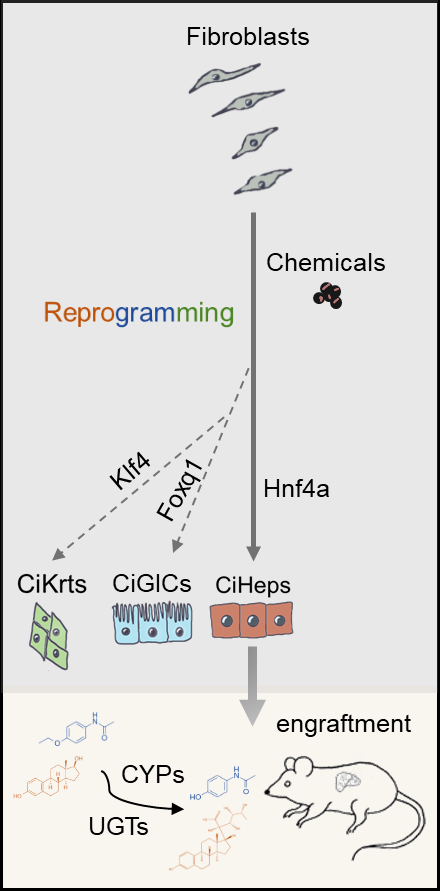Zhao Yang’s team successfully generates hepatocyte-like cells with capacity for liver repopulation
Aug 16, 2022
Peking University, August 16, 2022: Cell fate can be directly reprogrammed from accessible cell types (e.g., fibroblasts) into functional cell types by exposure to small molecule stimuli. However, no chemical reprogramming method has been reported to date that successfully generates functional hepatocyte-like cells that can repopulate liver tissue, casting doubt over the feasibility of chemical reprogramming approaches to obtain desirable cell types for therapeutic applications.
Through chemical induction of phenotypic plasticity, a research team led by Professor Zhao Yang, from the College of Future Technology (CFT) at Peking University, has achieved the direct chemical reprogramming that can generate hepatocyte-like cells with high-quality physiological properties. Their research findings were published in HEPATOLOGY on July 26 entitled “Direct chemical induction of hepatocyte-like cells with capacity for liver repopulation”.
According to the research paper, the team has provided a proof-of-concept demonstration of the direct chemical reprogramming of mouse fibroblasts into functional hepatocyte-like cells using exposure to small molecule cocktails in culture medium to successively stimulate endogenous expression of master transcription factors (TFs) associated with hepatocyte development, such as Hnf4a, Nr1i2, and Nr1h4.
Graph that shows the direct chemical reprogramming of mouse fibroblasts
RNA sequencing (RNA-seq) analysis, metabolic assays, and in vivo physiological experiments show that chemically-induced hepatocytes (CiHeps) exhibit comparable activity and function to primary hepatocytes, especially in liver repopulation to rescue liver failure in Fah–/–Rag2–/–Il2rg–/– (FRG) mice in vivo. Single-cell RNA-seq further revealed that gastrointestinal-like and keratinocyte-like cells were induced along with CiHeps, resembling the activation of an intestinal program within hepatic reprogramming as described in transgenic approaches.
The research findings demonstrate that direct chemical reprogramming can generate hepatocyte-like cells with high-quality physiological properties, providing a paradigm for establishing hepatocyte identity in fibroblasts, and demonstrating the potential for chemical reprogramming in organ/tissue repair and regeneration therapies.
Bai Yunfei, a doctoral candidate from the College of Future Technology (CFT) at Peking University, is the first author of the research paper, with Dr. Yang Zhenghao being the second author and Zhao Yang, a research fellow at the Center for Life Sciences (CLS), being the corresponding author. Dr. Xu Xiaochan from the Niels Bohr Institute, Dr. Ding Wanqiu and Qi Juntian, a postgraduate student from the CFT, provided assistance with the transcriptome analysis experiments. This work also received support from the National Key Research and Development Program of China and the National Natural Science Foundation of China.
References:
1. Cao S, Yu S, Chen Y, Wang X, Zhou C, Liu Y, et al. Chemical reprogramming of mouse embryonic and adult fibroblast into endoderm lineage. Journal of Biological Chemistry. 2017;292:19122–19132.
2. Li X, Liu D, Ma Y, Du X, Jing J, Wang L, et al. Direct reprogramming of fibroblasts via a chemically induced XEN-like state. Cell Stem Cell. 2017;21:264–273.
3. Huang P, He Z, Ji S, Sun H, Xiang D, Liu C, et al. Induction of functional hepatocyte-like cells from mouse fibroblasts by defined factors. Nature. 2011;475:386–391.
4. Sekiya S, Suzuki A. Direct conversion of mouse fibroblasts to hepatocyte-like cells by defined factors. Nature. 2011;475:390–395.
5. Yang Z, Xu X, Gu C, Nielsen AV, Chen G, Guo F, et al. Chemical Pretreatment Activated a Plastic State Amenable to Direct Lineage Reprogramming. Frontiers in Cell and Developmental Biology. 2022;10.
Source: PKU News (Chinese)

